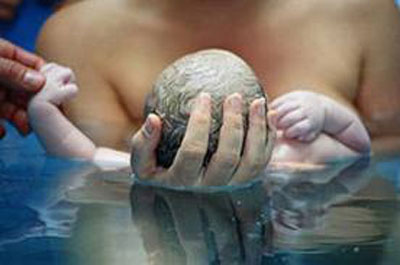 We explore the pros and cons of waterbirth in this article. A calmer, gentler transition for both mother and baby sounds like the dream birth. Some women choose a water birth for this reason.
We explore the pros and cons of waterbirth in this article. A calmer, gentler transition for both mother and baby sounds like the dream birth. Some women choose a water birth for this reason.
From the baby’s perspective, it’s thought to create a seamless entry into the world. They go from the “water” inside your womb to the water outside. As a mother, you can imagine how the support of soothing, warm water would help you relax into the birth process.
Intuitively, water birth might already make sense. However, it is essential to explore the pros and cons of waterbirth. Thankfully, we now have a reasonable amount of research to help you make a more confident, evidence-based choice.
Benefits for mum
One of the most substantial positives of water birth is an empowering and satisfying birth experience. A 2014 review looked at all the results of 38 studies from around the world. It indicated that birthing in water increases mothers’ satisfaction with their birth experience. Recently, a 2018 US study found women who use water immersion in birth had more positive experiences compared with those who didn’t. Similarly, women in a 2019 Swedish study felt more in control during the second stage of labour (pushing) compared to women having a non-water birth.
When thinking about a “good” birth experience, what about your perception of pain? Women who had a water birth consistently reported a lower level of pain in both the 2014 review and the recent Swedish study. Likewise, in a 2009 randomised controlled trial (a robust study design), researchers measured how much pain medication women used. Only 3.8% of those in the water birth group used medication compared to 100% in the non-water birth group.
There has been talk of other benefits for mothers of warm water immersion and waterbirth. It may facilitate a shorter labour. Or perhaps reduce your chance of tears or episiotomy (a cut to reduce tearing around the vagina). Additionally, waterbirth may increase physiological (normal) birth. But so far, the evidence has given us conflicting results. So we can’t yet say whether these are genuine benefits or not.

Downsides of water birth
As there are upsides of water immersion, there are some potential downsides and practicalities to think about ahead of time.
The first is preparing for emergencies. In the unlikely case of a situation where you need to change to plan B, a land birth, you’ll need a way to get out of the pool quickly. Even if you’re unwell, hospitals that offer water birth would already have a robust plan in place to help a woman out of the water in the case of an emergency.
You’ll also need to work out where you can access water birth in a hospital, or who is qualified to support water birth at home safely. Not every birthing facility offers warm water immersion during labour or water birth. Even when you can access water birth nearby, it’s not an option for everyone. Health care providers may decline to provide water immersion or waterbirth for women with certain conditions. For example, women who are:
- Expecting twins or triplets
- Experiencing premature labour
- Baby is in a breech position
- Have an infection
- Are bleeding in labour
Nevertheless, some women who cannot birth in water may still be able to labour in a birth pool. As always, it’s best to get personal advice from your midwife or doctor.
Outcomes for baby
 Several reviews of a large number of studies have tried to work out whether water births are more or less risky for babies. The studies have not shown us any particular pros or cons of waterbirth for babies compared to conventional, non-waterbirths.
Several reviews of a large number of studies have tried to work out whether water births are more or less risky for babies. The studies have not shown us any particular pros or cons of waterbirth for babies compared to conventional, non-waterbirths.
On the whole, outcomes for babies are the same in water immersion and non-water births. However, we don’t yet have enough research on infrequent problems that can crop up in labour and birth. Because they don’t happen often, we can’t tell if they are more or less likely to occur in water birth.
A rare occurrence called an umbilical cord snap might occur at a slightly higher rate in waterbirths compared to land births. The jury, however, is out on this one.
A common question about birthing in a pool is whether bub will breathe in water. Newborns have a clever reflex that stops them doing this. A 2017 review found the chance of babies having trouble breathing was lower for babies born underwater.
Pros and Cons of Waterbirth Summarised
More research is needed, but this is a quick summary of what we currently know:
Pros of Waterbirth
- Increased chance of an empowering and satisfying birth experience
- Less pain in labour
- Possible shorter labour
- May decrease vaginal tear rate
- Potentially a higher physiological (normal) birth rate
Cons of Waterbirth
- Not all maternity hospitals provide waterbirth as an option
- Hospitals may not offer women with increased risk factors the option of waterbirth
- Possibly a slight increase in umbilical cord snaps
- We need more evidence to help you make a genuinely informed choice
In line with the research, the formal position of Australian and New Zealand obstetricians (RANZCOG) is that water birth doesn’t seem risky for either mums or bubs. “To date, there is no evidence of increased maternal, fetal or neonatal risk associated with water immersion, compared with labouring and giving birth on land”. RANZCOG recommends that pregnant women should receive information about labour and birth in water.
Reference List
PBB aims to keep you informed with the latest research-based information. Check out our reference list used in the creation of this article.
Published 17th October 2020


During the waterbirth of my daughter I found that the birth pool naturally provided my own sacred space in which to birth. A space where only those I invited could enter. My very own birthing cocoon.